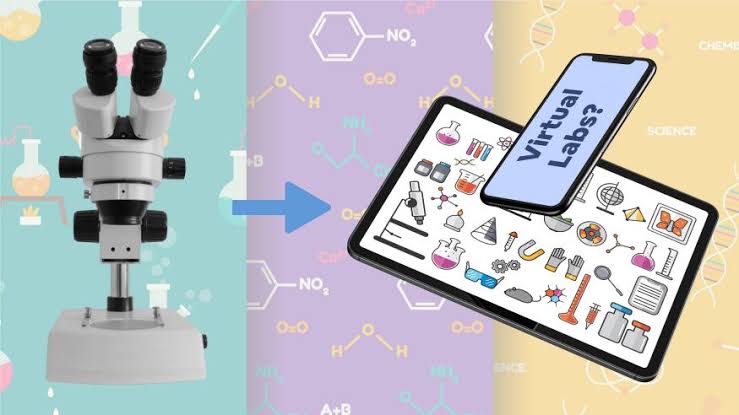A virtual laboratory is a computer-based activity in which students use a computer interface to interact with a scientific instrument or other apparatus. Learners can practice in a safe, online setting with virtual laboratories, or virtual labs, for short.
The pandemic’s recent surge in online learning has resulted in a considerable increase in the use of virtual labs for educational purposes. Students can engage with elements, machines, and interfaces before or instead of testing them out in the actual world. They can do this by using virtual scientific lab games and engineering simulation software.
What Are Virtual Labs?
Virtual labs are simulated learning environments that enable students to do laboratory experiments online. They further help learners investigate concepts and theories without having to visit a physical laboratory. Educators regard virtual laboratories as one of the most important e-learning resources. That is to say, they make it possible for both teachers and students to attain the objectives of the educational process.
In a virtual lab, educators utilize the computer to create a 3D virtual environment for the Science lab. This allows students to coexist, interact, and deal with it in all dimensions. Additionally, it gives them the impression that they are in a genuine laboratory. Students can test out new lab procedures and have a better understanding of complex lab equipment that may otherwise be unavailable. In addition, they can look inside the machinery they are running and understand life science at a molecular level using animations. Consequently, virtual labs make possible alternative access to Science education.
Physical Labs v/s Virtual Labs
In contrast to a physical lab, virtual labs allow educators to provide students with an unlimited amount of time to repeat and engage in experiments. Virtual laboratories, in fact, allow students to manipulate time. They can speed up time to complete experiments and analyze data faster. In addition, they can slow time down to understand the nuances of fast chemical processes, and go back in time to repeat experiments numerous times. Students can easily go back in time and try the process again if they make a mistake. That means they will save a lot of time, and because the equipment is virtual, they will not spend any resources. Educators allow students to visually encounter complicated subjects that might otherwise be too abstract or complex to study in a typical course by employing a virtual lab.
Experiments in a virtual lab allow teachers to immerse their pupils in a unique, educational, and immersive experience that is relevant and applicable in the real world. Students can explore new and exciting locations and experiment freely in a lab with complex machines that they might not otherwise have access to. When working in a lab, safety is of the utmost importance. However, students are often unprepared for the experiments they are doing. They are uninformed of what can happen if something goes wrong in the lab, putting them at risk. If students are inexperienced with the safety process, virtual laboratories are a safer place for them to practice than a physical lab. Virtual labs are analogous to flight simulators, which are used to train future pilots. Students can study and practice their skills in a lab simulator before attending a real lab.
Rise Of Virtual Labs
As academic institutions and businesses seek to minimize costs, increase student knowledge, develop new training methods, and reach a wider audience with hands-on teaching, the development and use of “virtual labs” is growing. The recent growth in online learning due to the pandemic has resulted in a significant increase in the utilisation of virtual labs for instructional purposes. Virtual labs offer the practice of complex operations without risk or additional cost, ranging from simple 2D computer programs with a few variables to completely immersive 3D experiences.
Virtual labs have numerous advantages, including lower costs, the flexibility to repeat an experiment with only one variable changed, decreased space requirements, no time constraints, increased health and safety training, and the capacity to express abstract ideas that are normally inaccessible. All of these elements combine to emphasize the necessity of virtual labs for training purposes. Virtual labs have allowed students and trainees to continue working despite the required social separation and encouragement to work from home throughout the year when COVID-19 has been widespread.
How To Use Virtual Labs In Modern Times?
Virtual laboratories encourage experimentation and interactivity between learners and instructors. As a result, they can assist educators in providing a more engaging learning experience. Here are some guidelines and examples of how virtual labs might be used in online learning courses:
- Educators must allow learners to enjoy the process of discovery rather than making assumptions or memorising concepts and procedures. They can pose situational questions to students, and then allow them to recreate those events in the virtual lab. The following lesson might be about any differences between expectations and (virtual) reality.
- To assist learners in improving their abilities, educators can use virtual laboratory interfaces. Learners can use the virtual lab software to practice increasingly complex processes and more difficult assignments as they master simple operations.
- Educators can provide learners with lab-style projects that show them how to use a physical laboratory in a step-by-step manner. They can include safety precautions and advice on how to operate the item properly.
- Lastly, educators must choose a responsive interface when creating their virtual laboratory. Learners will be able to use any device to complete their course. A rich and interactive user interface will also provide a fluid and adaptable learning experience.
Benefits And Impediments Of Virtual Labs
Benefits:
The following are some of the advantages of using virtual training labs:
- Virtual training labs allow for more flexibility in scheduling. Virtual training laboratories do not require on-site employees to keep them open or updated. They are available whenever students need them as long as they have high-speed internet.
- Student development is aided by training, which results in increased productivity. Virtual training laboratories are a cost-effective approach to provide all learners with a diverse set of educational opportunities.
- Virtual training laboratories are controlled and secure, providing learners with a safe environment in which to practice their abilities without the risk of corrupting live data, disclosing sensitive information, or damaging costly gear.
- Employees can learn critical, career-advancing skills without having to travel or take time off. They can do this by using practical skill acquisition methods that cause minimal disruption to their work schedules.
Impediments:
Of course, no single form of instruction has all of the answers. Virtual training labs have several pitfalls, especially if one tries to implement them in a workplace that is not already digitally sophisticated and up to date on the latest developments. Here are a few drawbacks to consider:
- Learners who are still adjusting to a technologically intensive work environment may not enjoy online training. Moreover, they may find it difficult to appreciate its benefits.
- Virtual training laboratories are a novel and unique way to study. Mastering them is a talent in and of itself. The transition from traditional to virtual learning may be unsettling for some learners.
- Before they feel comfortable using virtual training labs, some learners may require general technical skills training.
- Prerequisite technological skills training could slow down the rollout of virtual training laboratories. It could overwhelm support staff with inquiries about how to utilize them.
- Assessing the potential learners’ technological abilities is just as vital as offering the virtual instruction itself, but it may be time-consuming and costly.
- In addition, one must take into account the time, money, and effort it takes to prepare and educate instructors and other key employees to teach electronically.
Designing Your Own Virtual Lab
If one understands the basics and is willing to spend a decent amount on hardware, creating their own virtual lab is simple. Users can consider a lab investment as an investment in themselves, if that helps. Since one can add false hosts, fake CPUs, pretend networks, fake clusters, and fake load balancing to a virtual lab, it outperforms physical clusters.
One may design and modify their own virtual machine lab using the Virtual Machines(VM) application. To back up a virtual lab, one must utilize the CommCell Console, which is linked to the Web Console. The contents of a person’s virtual lab are only visible to them and their administrator.
Procedure
1) Firstly, go to the Web Console, login and click on Virtual Labs.
2) Click on ‘Create Virtual Lab’ in the top-right corner of the page and select the name of a Virtual Lab Policy from the Virtual Lab Template list, then click Next.
One will not see this box if they just have one VM lab template available. Therefore, the Name page shows first in this situation.
3) On the Name page, give your VM lab a name, a description, and an expiration date.
6) After that, users must define the number of CPUs and RAM for each virtual machine in the lab on the Configuration page. This includes entering the number of processors for each virtual machine in the Number of CPUs box and filling in the memory size for each virtual machine in the Memory box. Following this, click Next.
7) Fill in a password for the virtual lab on the User Details screen, then click Next.
8) Lastly, click Finish on the Summary page. The virtual lab will appear in the Virtual Labs list once it has been built. It is possible that the creation process may take several minutes to complete.
Users will automatically receive an email confirming the establishment of their virtual machine.
Are Virtual Labs The Future Of Education?
In conclusion, one must investigate virtual laboratories, like all classroom technology, to ensure that their fundamental objective is being met beneath the showy features. Of course, this will require some time and testing. However, it is definitely achievable with the correct mix of in-person and online lectures.
There is no greater way to learn in life than by getting practical experience. Learners will get valuable experience throughout the training phase without depleting resources or having a significant impact on a company’s professional activities. As far as we can tell, it is a win-win situation.
Image Sources: Shutterstock and Unsplash
Also Read: Pedagogical Practices To Suit Various Learning Styles
For more information on virtual labs, visit our blog.
Create. Engage. Inspire.















